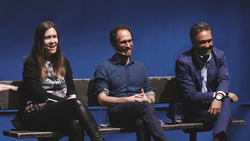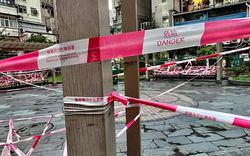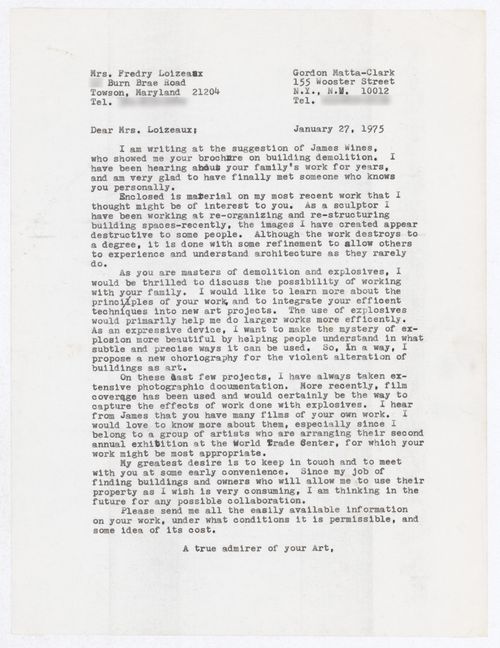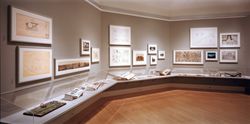No Parks?
Are parks bad? These quarantined bits of land and water speak to a confused desire for some kind of “nature”—and they might be good for our health—but do they also serve to excuse our continued bad behaviour? Parks are not innocent. City parks are real estate assets and urban “amenities” created by planners, landscape architects, hydrological engineers, police(...)
25 May 2017
No Parks?
Actions:
Description:
Are parks bad? These quarantined bits of land and water speak to a confused desire for some kind of “nature”—and they might be good for our health—but do they also serve to excuse our continued bad behaviour? Parks are not innocent. City parks are real estate assets and urban “amenities” created by planners, landscape architects, hydrological engineers, police(...)
Project
AP164.S1.1996.D4
Description:
The project series documents the competition entry for the design and construction of the Valdemingómez recycling plant for urban waste, as well as offices. The plant is located in the Southeast Regional Park (Parque Regional del Sureste). In 1997, Abalos & Herreros in collaboration with Vertresa won first place in the competition. The firm identified this project as number 99. The plant has “[…] two complementary constructions, one intended for the elaboration of compounds from organic waste, and the second, the control and weighing of the lorries that enter the area. […] The facility has a working life of 25 years. After that time it can be recycled as an amenity for the Regional Park or be dismantled by recycling its components” (ARCH270971). The firm received several awards and recognitions for the Valdemingómez plant. In 2000, they received the award of Urbanismo, Arquitectura y Obra Pública 1999 from the Madrid City Council, made it to the selection process at the premios FAD de Arquitectura e Interiorismo 2000, and obtained a prize from the Colegio Oficial de Arquitectos de Madrid. In 2001, this project was also a finalist for the Premio Mies van der Rohe and received second place for the Premio Manuel de la Dehesa. The plant received an award at the fourteenth Premio Grupo Dragados de Arquitectura de la Fundación CEOE and was also selected at the third Bienal Iberoamericana de Arquitectura e Ingenieria Civil in 2002. Documenting the project are competition and working drawings, logbooks, notes, correspondence, studies, reports, proposals, receipts, press releases, clippings promotional, reference, digital, photographic and graphic materials, and a model.
1995-2001
Planta de reciclaje de residuos urbanos de Valdemingómez, Madrid, Spain (1996-1999)
Actions:
AP164.S1.1996.D4
Description:
The project series documents the competition entry for the design and construction of the Valdemingómez recycling plant for urban waste, as well as offices. The plant is located in the Southeast Regional Park (Parque Regional del Sureste). In 1997, Abalos & Herreros in collaboration with Vertresa won first place in the competition. The firm identified this project as number 99. The plant has “[…] two complementary constructions, one intended for the elaboration of compounds from organic waste, and the second, the control and weighing of the lorries that enter the area. […] The facility has a working life of 25 years. After that time it can be recycled as an amenity for the Regional Park or be dismantled by recycling its components” (ARCH270971). The firm received several awards and recognitions for the Valdemingómez plant. In 2000, they received the award of Urbanismo, Arquitectura y Obra Pública 1999 from the Madrid City Council, made it to the selection process at the premios FAD de Arquitectura e Interiorismo 2000, and obtained a prize from the Colegio Oficial de Arquitectos de Madrid. In 2001, this project was also a finalist for the Premio Mies van der Rohe and received second place for the Premio Manuel de la Dehesa. The plant received an award at the fourteenth Premio Grupo Dragados de Arquitectura de la Fundación CEOE and was also selected at the third Bienal Iberoamericana de Arquitectura e Ingenieria Civil in 2002. Documenting the project are competition and working drawings, logbooks, notes, correspondence, studies, reports, proposals, receipts, press releases, clippings promotional, reference, digital, photographic and graphic materials, and a model.
Project
1995-2001
textual records
PHCON2002:0016:003:031
5 February 1975
textual records
5 February 1975
articles
Everyday Safety: Beware of Falling Fruit
Sony Devabhaktuni and Joanna Mansbridge on performances of everyday safety in Hong Kong
Actions:
Keep Safe
Project
AP018.S1.1960.PR02
Description:
This project series documents the Imperial Oil Ontario region office in North York, Ontario from 1960-1962. The office identified the project number as 6049. This project consisted of a three-storey, 110,000 square foot building located at the corner of Don Mills Road and Eglington Avenue. The front entrance was accessed from a circular driveway off Wynford Drive, with parking lots on either side that held 330 vehicles. The basement level had storage rooms, machine and boiler rooms, a telephone switch gear room and shipping areas. The first floor included food service areas, offices, locker rooms, and a doctor's office complete with x-ray rooms, treatment areas and a quiet room for female employees, among others. The second floor contained administrative areas for accounting, data control and banking, while the third floor contained more offices. The building's frame consisted of a rectangular steel skeleton faced with concrete panels. The ground level was recessed 20 feet to allow for sidewalks around the building. Concrete columns at this level supported the upper two storeys. The landscaped surroundings include long, fountain-spotted reflecting pools. This project won the silver Massey Medal for Architecture in 1964, as well as an honourable distinction at the International Exhibition of Architects VIII Biennial of São Paula in 1965. The project is recorded through drawings, textual records and a photograph dating from 1961-1970. The drawings are mostly reprographic copies that include plans, sections, elevations, details, schedules and electrical, mechanical and structural drawings. The textual records consist of specifications originally arranged with the drawings. The photograph shows the finished buillding.
1961 - 1970
Imperial Oil Limited, Ontario Region Office Building, North York (1960-1962)
Actions:
AP018.S1.1960.PR02
Description:
This project series documents the Imperial Oil Ontario region office in North York, Ontario from 1960-1962. The office identified the project number as 6049. This project consisted of a three-storey, 110,000 square foot building located at the corner of Don Mills Road and Eglington Avenue. The front entrance was accessed from a circular driveway off Wynford Drive, with parking lots on either side that held 330 vehicles. The basement level had storage rooms, machine and boiler rooms, a telephone switch gear room and shipping areas. The first floor included food service areas, offices, locker rooms, and a doctor's office complete with x-ray rooms, treatment areas and a quiet room for female employees, among others. The second floor contained administrative areas for accounting, data control and banking, while the third floor contained more offices. The building's frame consisted of a rectangular steel skeleton faced with concrete panels. The ground level was recessed 20 feet to allow for sidewalks around the building. Concrete columns at this level supported the upper two storeys. The landscaped surroundings include long, fountain-spotted reflecting pools. This project won the silver Massey Medal for Architecture in 1964, as well as an honourable distinction at the International Exhibition of Architects VIII Biennial of São Paula in 1965. The project is recorded through drawings, textual records and a photograph dating from 1961-1970. The drawings are mostly reprographic copies that include plans, sections, elevations, details, schedules and electrical, mechanical and structural drawings. The textual records consist of specifications originally arranged with the drawings. The photograph shows the finished buillding.
Project
1961 - 1970
Project
New Westminster Pier
AP144.S2.D106
Description:
File documents a competition entry for a new pier on the Thames in the City of Westminster, London, England. The Westminster pier project consisted of a restaurant with deck and observation tower, a fixed pier or public walkway, a catwalk, various ramps, and a pontoon. Existing conditions drawings and photographs include: a hydrographic plan, site plan, and section of the pier and pier edge; an enlarged contact sheet of photographs of the site and surrounding area; and a photocopy of a photograph of a typical pier boat, possibly used for reference purposes. Conceptual sketches include numerous thumbnail and annotated diagrammatic sketches which explore the functional relationships of the areas encompassed by the project. Design development drawings show sections through river embankments, restaurant and tower structures, walkways, ramps, and catwalks, at high and low tide and at night and during the day. Axonometric drawings show the principal structures, circulation paths, and access and control points. A group of drawings are probably a competition entry set marked by a hole punched in the upper right hand corner. Presentation panels are composed of reproductions of photographs of the existing site with overdrawing and montage which shows Price's project in relationship to the river. Two presentation panels which show the walkway/ramp, pontoon, and restaurant in partial elevation have been coloured with airbrush. Duplicate reprographic copies were made from the original design development drawings, and some are annotated with notes. File also contains clippings about "sub-marine engineering" which are possibly related to this project. Material in this file was produced in 1979. File contains conceptual drawings, presentation drawings, reference drawings, presentation panels, and textual records.
1979
New Westminster Pier
Actions:
AP144.S2.D106
Description:
File documents a competition entry for a new pier on the Thames in the City of Westminster, London, England. The Westminster pier project consisted of a restaurant with deck and observation tower, a fixed pier or public walkway, a catwalk, various ramps, and a pontoon. Existing conditions drawings and photographs include: a hydrographic plan, site plan, and section of the pier and pier edge; an enlarged contact sheet of photographs of the site and surrounding area; and a photocopy of a photograph of a typical pier boat, possibly used for reference purposes. Conceptual sketches include numerous thumbnail and annotated diagrammatic sketches which explore the functional relationships of the areas encompassed by the project. Design development drawings show sections through river embankments, restaurant and tower structures, walkways, ramps, and catwalks, at high and low tide and at night and during the day. Axonometric drawings show the principal structures, circulation paths, and access and control points. A group of drawings are probably a competition entry set marked by a hole punched in the upper right hand corner. Presentation panels are composed of reproductions of photographs of the existing site with overdrawing and montage which shows Price's project in relationship to the river. Two presentation panels which show the walkway/ramp, pontoon, and restaurant in partial elevation have been coloured with airbrush. Duplicate reprographic copies were made from the original design development drawings, and some are annotated with notes. File also contains clippings about "sub-marine engineering" which are possibly related to this project. Material in this file was produced in 1979. File contains conceptual drawings, presentation drawings, reference drawings, presentation panels, and textual records.
File 106
1979
PHCON2002:0016:003:030
27 January 1975
textual records
ARCH270555
Description:
The document was kept with project Viviendas, locales y garajes en la M-30 (AP164.S1.1988.D3). Further investigation is required.
November 1993
Competition documents for the Concurso de viviendas y urbanizacion sobre la parcela 1 de 'La Cañada Real', Spain
Actions:
ARCH270555
Description:
The document was kept with project Viviendas, locales y garajes en la M-30 (AP164.S1.1988.D3). Further investigation is required.
textual records
November 1993
Project
AP056.S1.1995.PR06
Description:
This project series documents renovations to the concert hall of the Royal Conservatory of Music in Toronto from 1995-1996. The office identified the project number as 9512. This project consisted of restauration work and renovations to the existing Castle Memorial Hall, part of the music school originally built in 1901, now renamed the Ettore Mazzoleni Concert Hall. This project was part of a larger master plan, created by KPMB in 1991 under the direction of Marianne McKenna, that outlined multiple phases of renovations and additions to the school (see file AP056.S1.1991.PR07.010 for complete master plan). The restauration work included opening bricked-over windows, removing paint and acoustic panels, and opening the original stair tower. Renovations included the addition of a curved mahogany stage, new maple floors and new acoustic controls. The 6,000 square foot performance venue held 240 seats.[1] The project is recorded through drawings and a presentation painting dating from 1994-1997. The drawings include plans, sections, elevations, details and millwork and furnishings drawings. [1]"Royal Conservatory / Ettore Mazzoleni Hall." KPMB. Accessed March 15, 2019. http://107.23.26.92/project/royal-conservatory-ettore-mazzoleni-hall/.
1994-1997
Royal Conservatory of Music, Memorial Concert Hall Renovations, Toronto (1995-1997)
Actions:
AP056.S1.1995.PR06
Description:
This project series documents renovations to the concert hall of the Royal Conservatory of Music in Toronto from 1995-1996. The office identified the project number as 9512. This project consisted of restauration work and renovations to the existing Castle Memorial Hall, part of the music school originally built in 1901, now renamed the Ettore Mazzoleni Concert Hall. This project was part of a larger master plan, created by KPMB in 1991 under the direction of Marianne McKenna, that outlined multiple phases of renovations and additions to the school (see file AP056.S1.1991.PR07.010 for complete master plan). The restauration work included opening bricked-over windows, removing paint and acoustic panels, and opening the original stair tower. Renovations included the addition of a curved mahogany stage, new maple floors and new acoustic controls. The 6,000 square foot performance venue held 240 seats.[1] The project is recorded through drawings and a presentation painting dating from 1994-1997. The drawings include plans, sections, elevations, details and millwork and furnishings drawings. [1]"Royal Conservatory / Ettore Mazzoleni Hall." KPMB. Accessed March 15, 2019. http://107.23.26.92/project/royal-conservatory-ettore-mazzoleni-hall/.
Project
1994-1997
Cedric Price: Mean Time
British architect Cedric Price draws upon the collection of the CCA to develop the complex relationships between time, movement, and space in the built environment. Looking at structures and building elements through the ages, including some of Price’s own projects, Mean Time presents photographs of an ancient Aztec sun dial, a railroad switching yard, a shot tower, and a(...)
Octagonal gallery
19 October 1999 to 27 February 2000
Cedric Price: Mean Time
Actions:
Description:
British architect Cedric Price draws upon the collection of the CCA to develop the complex relationships between time, movement, and space in the built environment. Looking at structures and building elements through the ages, including some of Price’s own projects, Mean Time presents photographs of an ancient Aztec sun dial, a railroad switching yard, a shot tower, and a(...)
Octagonal gallery



